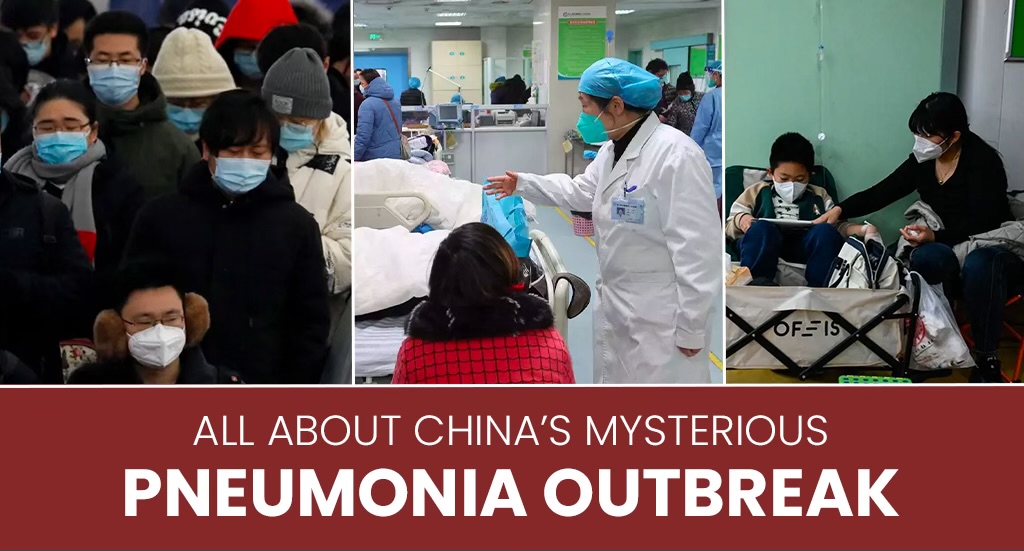The unexpected appearance of the mysterious pneumonia outbreak in China, sweeping through schools and educational institutions, unveiled the enormous mystery of the Universe once again. Its influence has been significant, quickly changing realities. The number of illnesses is rising, with over 7000 documented cases till date. Hospitals are overwhelmed with sick children who have reported symptoms, including lung inflammation and high fever. Earlier in 2020, the global economic stability was ruthlessly undermined by the COVID pandemic. And the mysterious outbreak has created massive havoc among people all across the globe.
When the outbreak was first discovered in northern China, a significant number of cases were reported among children. Patients exhibiting symptoms similar to pneumonia – caused by an unknown infection – flooded hospitals in the afflicted regions. According to a statement from the World Health Organisation, the National Health Commission of China discussed the increase in respiratory infections at a news meeting on November 13.
The focal point of the outbreak is located in Beijing and the province of Liaoning, where medical facilities are dealing with a surge of sick children exhibiting symptoms similar to pneumonia. Since both children and teachers have been impacted by the illness, the seriousness of the situation has resulted in the temporary closure of classes in several schools, which reminds people of the dark and early stages of the COVID-19 outbreak.
In response to China’s pneumonia cases, the World Health Organisation (WHO) has asked for further information and urged the country to take steps to reduce infection risks.
Fever, cough, and respiratory difficulties are among the symptoms of the sickness, which can range in severity and require hospitalisation for some people. Chinese officials link the increase in respiratory illnesses to the easing of Covid-19 regulations and the existence of known diseases such as the Covid-19 virus, mycoplasma, pneumonia, influenza, and respiratory syncytial virus (RSV).
The question – why it’s always China bothers many. However, Mr Bharat Pankhania, an infectious diseases expert with University of Exter Medical School, UK believes ironically, China pursued a “Zero Covid” strategy that has now backfired. The country imposed strict COVID-19 lockdowns on large segments of the populace for a protracted period — longer than many other countries. This led to a situation where the population was not as exposed to other respiratory viruses or bacteria at this time.
This population came into contact with all of these infections this winter after the limitations were laid off, which is what caused the unexpected spike in cases. Furthermore, what doctors call “immunological deficit”—a lack of natural immunity built via exposure to these infections—may have also resulted from the extended lack of exposure to these pathogens.
He said, “Immunological deficit is not surprising…but then you can have more people infected than expected because of circumstances like crowded schools, crowded shops, buses, trains…and there is winter now,”
“So it’s very difficult to disentangle [whether] it is an immunological deficit, or is it environmental circumstances. Or perhaps both,” he added.
World Health Organisation’s Take
In response to mounting public concern that the clusters might spread into a more widespread outbreak, the WHO released a press release on November 23. According to the press release, the Chinese government claimed that diagnosable bacterial and viral infections are to blame for the increase in illnesses in the area, and that remedies are available for them.
The global health authority is in regular contact with Chinese physicians and scientists who are actively monitoring the situation, according to the WHO report, which indicates that the situation is being closely watched. Additionally, they are provided with timely information on the established infections’ patterns of spread.
The WHO advises people in China to follow preventive measures against respiratory infections even as it looks into this further data. These precautions include obtaining the recommended vaccinations, avoiding contact with sick people, remaining at home when feeling under the weather, getting tested and seeking medical attention when needed, wearing masks when appropriate, making sure there is adequate ventilation, and regularly washing your hands.








